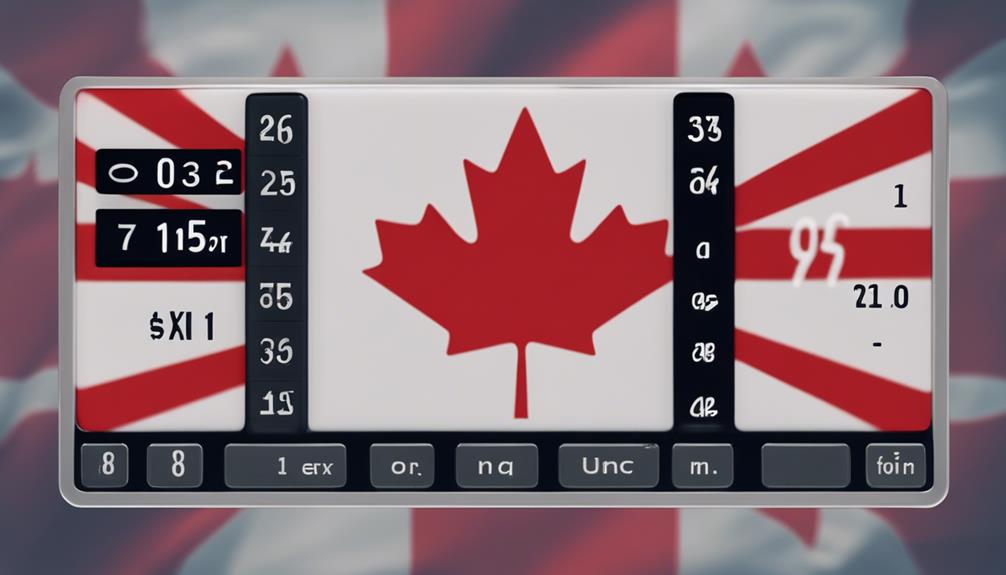In Canada, retirement income primarily comes from the Old Age Security (OAS) and Canada Pension Plan (CPP). CPP payment amounts depend on contributions, with the option to start at 60 or delay for increased benefits. OAS supports those 65 and older. Workplace pension plans like RPPs and Group RRSPs provide additional income. RRSPs and TFSAs offer personal savings options. Estimating retirement income involves understanding CPP and OAS benefits. Explore strategies like pension splitting for tax benefits. Learn about provisions like Child-Rearing and Disability to maximize CPP payments. Discover more insights into Canada's retirement plan for a clearer financial outlook.
Key Takeaways
- CPP replaces one-third of pre-retirement income.
- OAS provides support for individuals aged 65+.
- Delaying CPP or OAS leads to higher payments.
- Factors impacting retirement income estimation are crucial.
- Thorough retirement plan considers CPP and OAS rules.
OAS and CPP Monthly Support

In Canada's retirement system, the Old Age Security (OAS) and Canada Pension Plan (CPP) provide essential monthly financial support to seniors, each with distinct eligibility criteria and benefit structures.
The CPP retirement pension is based on the contributions made during a person's working years, with the pension amount varying depending on the individual's contributions. Seniors can choose to start receiving CPP as early as age 60, but delaying it can result in higher monthly payments. For each month deferred, there is a 0.7% increase in the pension amount, up to a maximum of 5 years.
On the other hand, OAS provides a monthly benefit for retirees aged 65 and older without the requirement of contributions. It is important to note that individuals with lower incomes may also be eligible for additional support through the Guaranteed Income Supplement (GIS) in addition to OAS, which offers non-taxable payments.
Moreover, both OAS and CPP offer survivor benefits to eligible individuals, providing financial assistance to the surviving spouse or partner.
Workplace Pension Options

Workplace pension options in Canada encompass various plans like Registered Pension Plans (RPP) and Group RRSPs, offering employees avenues for retirement savings. Defined Benefit Pension Plans provide a fixed income based on earnings and service years, while Defined Contribution Pension Plans rely on contributions and investment performance.
Understanding the importance of employer contributions, different types of pension plans, and eligibility criteria are key aspects to bear in mind when exploring workplace pension options for retirement planning.
Employer Contributions Importance
Employer contributions play a pivotal role in bolstering retirement savings through workplace pension options such as Defined Benefit Pension Plans (DBPP), Defined Contribution Pension Plans (DCPP), and Group RRSPs. These contributions are instrumental in helping individuals secure their financial future by supplementing their retirement funds.
Defined Benefit Pension Plans offer a fixed income based on salary and years of service, ensuring a stable financial foundation post-retirement. In contrast, Defined Contribution Pension Plans rely on contributions and investment performance, making employer contributions essential to enhancing the retirement savings potential.
Group RRSPs also provide a valuable opportunity for employees to save for retirement, with the added benefit of possible employer contributions that can greatly boost the overall retirement fund.
Workplace pensions, including these options, are essential components for individuals to build a secure retirement alongside government benefits like CPP and OAS.
Types of Pension Plans
Among the various retirement savings vehicles available to individuals, Registered Pension Plans (RPP) and Group Registered Retirement Savings Plans (GRRSP) stand out as essential workplace pension options providing valuable financial security in retirement years. Defined Benefit Pension Plans (DBPP) offer a fixed retirement income calculated based on salary and years of service, ensuring a predictable source of funds post-retirement.
On the other hand, Defined Contribution Pension Plans (DCPP) do not guarantee a specific retirement benefit, as the final amount depends on contributions and investment performance over time. Additionally, Group RRSPs allow employees to contribute towards their retirement savings, complementing other sources of retirement income.
These workplace pension options play an important role in retirement planning by diversifying income sources and enhancing financial stability during retirement.
Vesting and Eligibility
Discussing the eligibility and vesting requirements within retirement plans sheds light on the parameters that determine an individual's access to full pension benefits upon retirement.
- Vesting in workplace pensions is essential for ensuring eligibility for full retirement benefits.
- Defined Benefit Pension Plans (DBPP) provide a fixed retirement income based on years of service and salary.
- Workplace pension options like Group Registered Retirement Savings Plans (GRRSP) offer employees the chance to contribute towards their retirement savings.
- Contributions and investment performance play a significant role in Defined Contribution Pension Plans (DCPP) as they do not guarantee a specific retirement benefit.
Retirement Savings Choices

When planning for retirement in Canada, individuals have a range of retirement savings choices to contemplate, including Registered Retirement Savings Plans (RRSPs) and Tax-Free Savings Accounts (TFSAs). RRSPs allow contributions up to 18% of earned income annually, with the advantage of tax-deductible contributions. On the other hand, TFSAs have a 2022 contribution limit of $6,000 and a cumulative room of $81,500 since their introduction in 2009, offering tax-free earnings.
RRSPs typically hold various assets and tax investment income upon withdrawal. It is essential to take into account private savings alongside Canada Pension Plan (CPP) and Old Age Security (OAS) benefits for a comfortable retirement. By strategically utilizing RRSPs, TFSAs, and private savings, individuals can enhance their financial preparedness for retirement, ensuring a stable and secure financial future.
Making informed decisions regarding these retirement savings choices is vital for building a robust retirement plan that aligns with one's long-term financial goals.
Estimating Retirement Income

To accurately plan for retirement, individuals can utilize tools like the Canadian Retirement Income Calculator to estimate their future income streams. Estimating retirement income is an important step in financial planning. Here are some key points to keep in mind:
- The Canada Pension Plan (CPP) payments are designed to replace about one-third of the average pre-retirement income.
- The Old Age Security (OAS) program provides additional support for individuals aged 65 and older.
- Delaying CPP or OAS benefits can lead to higher monthly payments in retirement.
- Understanding the various factors that impact retirement income estimation, such as CPP and OAS rules, inflation, and investment returns, is essential for developing a thorough retirement plan.
CPP Payment Calculation

The calculation of CPP payments for retirement pension in Canada is influenced by factors such as contribution history and the chosen pension start age. Monthly pension amounts can vary based on when you start your CPP, with the standard age for starting being 65.
Starting your CPP earlier at 60 or delaying until 70 can have a substantial impact on the monthly benefits you receive. Waiting until age 70 to begin your CPP payments could potentially double your pension compared to starting at age 60.
It's important to calculate your CPP retirement pension at different ages to understand how it aligns with your financial goals. Consider factors like years until age, your health, financial situation, and retirement plans when deciding on the best time to start receiving CPP benefits.
Making an informed decision about when to start your CPP can help increase your CPP retirement income and ensure a more secure financial future.
Understanding Pension Sharing

Pension sharing offers significant benefits to married couples or common-law partners, allowing for the division of CPP benefits based on the duration of cohabitation during the contributory period.
In cases of divorce or separation, specific rules govern credit splitting to guarantee an equitable distribution of CPP contributions.
Understanding these regulations and options for pension sharing can help couples optimize their retirement income and navigate tax implications effectively.
Pension Splitting Benefits
In the domain of retirement planning for married couples in Canada, utilizing pension splitting benefits can greatly improve tax efficiency and overall financial well-being. When considering CPP pensions, pension sharing offers several advantages:
- Couples can reduce their tax liability by dividing CPP benefits strategically.
- Sharing pensions based on years lived together during the contributory period can lead to a fair distribution of retirement income.
- Pension splitting is beneficial for couples with disparate incomes, ensuring a more balanced financial outlook in retirement.
- Opting for pension sharing can be a smart financial move to maximize retirement funds and optimize tax savings for both partners.
Rules for Divorcees
Understanding the regulations surrounding pension sharing for divorcees is crucial to guaranteeing an equitable distribution of retirement benefits in Canada. Divorcees have the option to split CPP contributions with their former spouse, allowing for a fair division of retirement assets.
Pension sharing, including credit splitting, can play a significant role in reducing taxable income during retirement. By grasping the rules governing pension sharing, individuals can navigate the complexities of divorce and separation to safeguard their financial well-being in retirement.
Sharing CPP pensions with a former spouse requires careful consideration due to its potential impact on taxable income and overall retirement benefits. It is essential for divorcees to be well-informed about these regulations to make informed decisions regarding pension sharing and ensure a balanced distribution of assets.
Provisions for Higher CPP Payments

When considering ways to maximize Canadian retirement benefits through the CPP program, individuals should explore the various provisions designed to increase payment amounts. These provisions include:
- The Child-Rearing provision can increase CPP payments for periods spent raising children.
- Disability periods may also enhance CPP payments and qualify individuals for additional benefits.
- The General Drop Out provision allows for up to 8 years of lowest earnings to be excluded in the base pension calculation.
- Contributions made while working after age 65 can replace low-earning periods and increase the overall pension amount.
These mechanisms are essential for individuals looking to boost their CPP payments and secure a more comfortable retirement.
Frequently Asked Questions
How Do I Figure Out How Much CPP I Will Get?
To figure out your CPP amount, consider your contribution history and choose a pension start age. Options are 60, 65, or 70, with payments increasing if you delay. The Canadian Retirement Income Calculator offers estimates.
Monthly payments depend on your earnings and how long you contributed. Starting at 70 can double payments compared to starting at 60.
Review your history and use tools for an accurate estimate of your CPP retirement pension amount.
How Much Do You Get When You Retire in Canada?
When you retire in Canada, the amount you receive can vary based on factors like your contributions to the Canada Pension Plan (CPP), your average income during your working years, and the age at which you start receiving benefits.
The average monthly CPP payment in 2021 was $714.21, with a maximum of $1,203.75. Delaying retirement benefits can increase monthly payments, and additional factors such as survivor benefits and the Post-Retirement Benefit (PRB) can impact your overall pension amount.
How Much CPP Will I Get if I Take It at 60?
When considering taking your Canada Pension Plan (CPP) at age 60, keep in mind that your monthly payments will be approximately 36% lower than if you were to start at age 65. This decrease in payments is permanent and will impact the total amount received over your lifetime.
Conversely, delaying CPP until age 65 can lead to around 42% higher monthly payments.
How Many Years Do You Have to Work in Canada to Get a Pension?
To qualify for a pension in Canada, individuals need to have worked in the country and made qualifying contributions to programs like the Canadian Pension Plan (CPP).
The specific number of years required to be eligible for a pension varies depending on factors such as age and contributions made. Generally, individuals must have a work history in Canada and have contributed to the pension plan for a certain period to qualify for benefits upon retirement.
Conclusion
In the intricate web of retirement planning, Canadians must navigate various streams of income to secure a comfortable future. By understanding the nuances of OAS, CPP, workplace pensions, and personal savings, individuals can paint a clearer picture of their financial landscape in retirement.
Just as a skilled navigator charts a course through turbulent waters, so too must retirees carefully plan and allocate resources to guarantee a smooth journey into their golden years.










